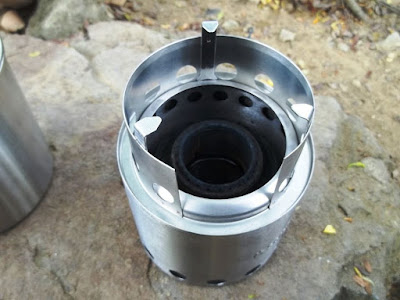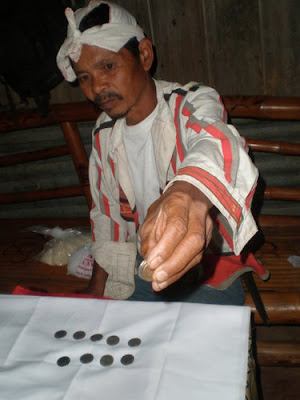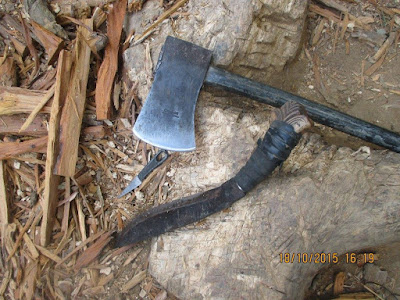IN
OCTOBER 2014, A US-based benefactor provided me a TRANGIA Spirit Burner set for
use then of my ongoing route-finding explorations of the Cebu Highlands Trail
Project. This project is a long trail of a north-to-south axis that would
traverse over the middle backbone of the island province of Cebu, in Central
Philippines, which I finished in November 2016.
The exploration has no source of funding nor big-name sponsors and I was asking a little for blessings from friends and appreciative people. A trickle came and one of these significant donations was a TRANGIA Spirit Bunrer set. It is made of brass. It weighs 108 grams, 7.5 centimeters in diameter and 4.5 centimeters in height. It has a screw cap and another cap where you could adjust and control the flame.
It
comes with a windscreen that can be dismantled in three pieces and assembled,
which has a total weight of 115 grams. The windscreen complemented well with
the burner as it propped the pot above it aside from its other function as a
mechanical wrench. By its size, weight and simplicity, I favored this burner
set in all my outdoor activities. Fuel I used is denatured alcohol which are
sold in 375-milliliter bottles.
During my explorations of the last six segments of this project between 2015 and 2016, where weight was very essential, the TRANGIA Spirit Burner set was just perfect. Each segment was between two to seven days duration and the volume of fuel I carried was fixed at 3 bottles x 150 ml or 450 ml total. With a self-contained load, the burner set fit into the tight spaces available, to include the fuel bottles.
Because
it was very simple to set up and use, I found myself many times, boiling water
for coffee or cooking instant soups by the trail. The process takes just inside
of fifteen minutes and the TRANGIA Spirit Burner set had saved me many times
regaining my strength where I need it most. This burner set have done well to
the demands of my explorations, the terrain and the tropical climate.
Although this was an equipment designed for the individual, I have used it many times to cater to two other persons while in camp. The simmer cap regulates the flame and saved fuel consumption as well as of overcooking; but when you have used this so many times, you could already estimate the amount of fuel you need and discard the simmer cap.
When I tested the Cebu Highlands Trail with a thruhike, naturally, the TRANGIA Spirit Burner set was part of my equipment. This thruhike was done in 29 days of January and February 2017, from the southernmost point of the island of Cebu up to its northernmost tip, covering 408+ kilometers of rugged terrain along the middle cordilleras.
The
alcohol burner worked mornings and evenings everyday; be it rainy or warm; cold
or humid; and, on a few occasions, mid-afternoon coffee breaks when I arrived
at my destinations very early. I have never experienced with a component
failure since it has no movable parts. For as long as I could feed it with
denatured alcohol, I will have my meals. Or coffee.
On other instances, like dirt-times with my bushcraft guild or travelling during training sessions, I experiment in pairing the TRANGIA Spirit Burner with a Swiss Army Wood Stove, when I still have the latter, and, lately, with a Solo Wood Stove. I would use the wood burner as an effective wind screen while increasing the heat efficiency of the alcohol burner, utilizing the construction and design of the wood stoves.
Presently,
the TRANGIA Spirit Burner totally complements my Solo Wood Stove by providing
the latter the capacity to use denatured alcohol when not using wood. The
alcohol burner perfectly fits inside the wood stove when packed that it transforms
into one unit although each could function without the other.
The TRANGIA Spirit Burner set has seen a lot of rough handling and use. I had seen it used for more than an hour of cooking under warm tropical conditions, stopping only when it burned all the fuel down and refilled and re-lit and repeating the process a couple of times more. Once the flames turned blue, it told me that the burner achieved a stable temperature ideal for cooking.
I
had seen it fall several times with nary a dent. Saw it explode a few times
when invisible flames lit fresh fuel poured in its superheated cauldron. I once
saw the metal surface where the blowholes are located glow red hot. One time, spilled
fuel burned all over it and I have to wait for several minutes before I could
intervene and cool it down.
The TRANGIA Spirit Burner is built to last. It is old technology yet quite relevant in these present times. It is made in Sweden and probably was designed in temperate and arctic regions yet it performed well in the tropics without fear of a meltdown. So simple and no movable parts and valves. What it has are a couple of screw caps.
This
is an equipment that I highly recommend for the active individual engaged in
leisure outdoor activities, like overnight camping, light backpacking and
hiking the long trails. Its fuel, the denatured alcohol or its similar
derivative can be acquired everywhere, comes very cheap and very safe to store.
It does not need a special container.
The TRANGIA Spirit Burner, which is a set, is available online in Amazon, eBay and most outdoors specialized stores. The windscreen is sold separately. Closer to home, it is available online in Lazada Philippines at 1,350 Philippine peso ($27.92), to include a mini-windscreen. But watch out for imitations. Insist on the original.
Picture Nr 1
grabbed from Trangia website.





























































